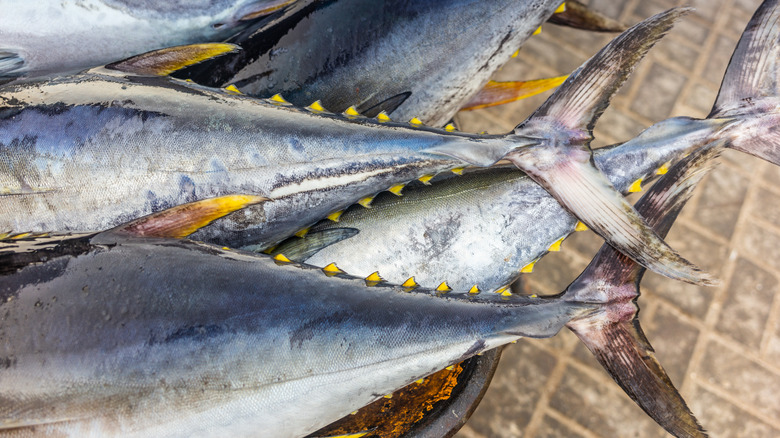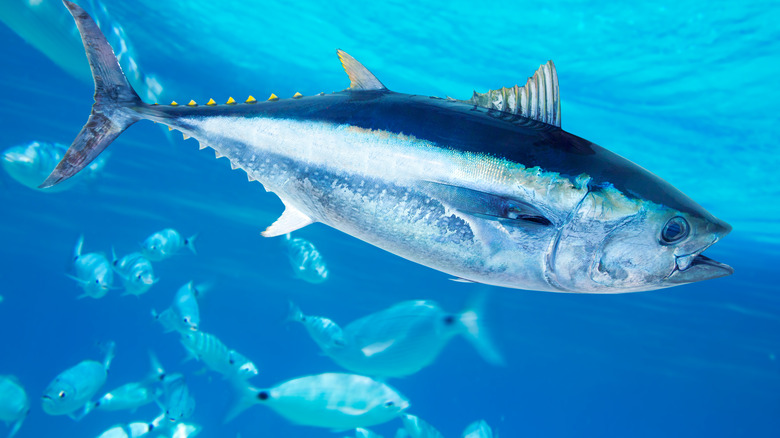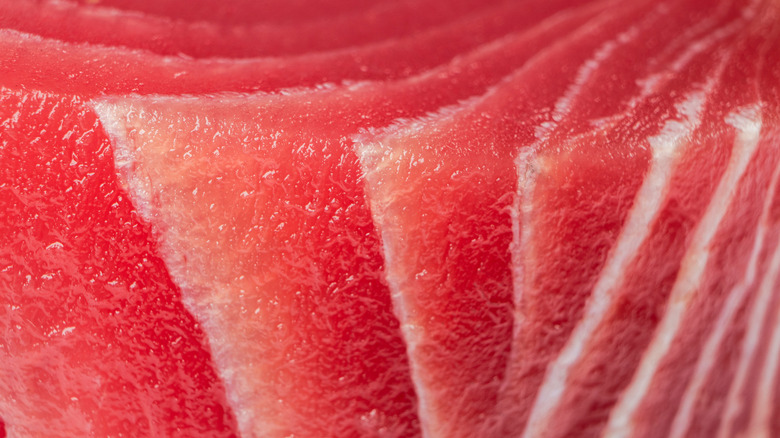Bluefin Vs. Yellowfin Tuna: What's The Difference?
Tuna is tuna, and it comes in a can, right? Not so when it comes to the yellow- and blue-finned beauties cruising the world's oceans with stunning speed, precision, and impressive deep-diving agility. Aptly named for their brilliant hues and living throughout the Atlantic, Pacific, and Indian Oceans, according to Dinko Seafoods, the bluefin and yellowfin tuna species are highly prized across the globe.
But it's not just the dazzling colors that contrast these two types of tuna; in fact, the differences between them are distinct in several ways, including size, temperature preference, and flavor. The bluefin stands out significantly for its high-brow reputation, fetching a price of $1.75 million for one fish, as reported by the World Wildlife Fund. That won't be quite as shocking when you discover the massive potential weights of this torpedo-shaped speed-swimmer.
When it comes to how you serve them in your home or order them from restaurant menus, the details matter. So here's a look at these two aquatic cousins from the Thunnus family of marine fishes.
Color and habitat
Each named for the vivid hues of their outer skins and fins, the yellowfin and bluefin tunas are easily identified according to those colors. Follow the color to spot a yellowfin tuna, which carries mostly bright yellows across its dorsal and anal fins and smaller finlets, explains the Hawaii Seafood Council. Likewise, a bluefin tuna showcases a dark blue tail complemented by varying hues of gray, lighter blues, yellow, and silver on its fins and underbelly, according to Dinko Seafoods.
From there, these giant fish diverge and define themselves in other ways, starting with where they live. Both bluefins and yellowfins whoosh through the world's major oceans and travel long distances, though they have different water-temp proclivities. Yellowfin tunas like to bask in warmer waters than their bluefin counterparts, which lean toward colder aquatic environments, explains Dinko.
The bluefin species, scientifically named Thunnus Thynnus, separates into three subspecies – the Pacific, Southern, and Atlantic – with the Atlantic species producing the largest fish, mostly caught in the Mediterranean Sea, the world's primary fishery for the prized bluefins (per World Wildlife Fund). Yellowfins, scientifically known as Thunnus albacares and part of the Hawaiian "ahi" designation, are a major source of fresh seafood in Hawaii, notes the Hawaii Seafood Council.
Size matters
Size makes a difference in the aquatic universe, and one tuna seriously outweighs all others. Bluefin tuna can weigh in at up to 1500 pounds and range from six to 10 feet long, per the World Wildlife Fund, meaning that a single fish can make or break a fishing fleet's profit margins. And those margins can be extraordinary, as that previously mentioned legendary sales price of $1.75 million for one fish can attest. The bluefin's torpedo-shaped body speeds through the water, sighting prey with the sharpest vision of fish of their kind, and they can dive more than 3,000 feet deep. Yellowfin, though considerably smaller, still weigh an impressive 400 pounds or more and stretch as long as seven feet, notes Oceana. They're also some of the speediest swimmers in the ocean, can live for up to seven years, and release as many as 4 million eggs into the water during a spawn.
The size of the bluefin species leads to monikers such as "Kings of the Tuna family," per Fishing Booker, but it's not just because their massive weight and breadth supplies more tuna for tables. It also affects flavor, which is a primary reason for its popularity.
Flavor and nutrition
Both yellowfin and bluefin tunas appear on sushi and sashimi menus across the continents. However, bluefin reigns supreme in this meal rendition due to its deliciously fatty flesh, explains Dinko Seafoods. The flavor is full and rich, and the "meaty" texture lends itself well to raw consumption in sashimi and sushi.
Even so, some tuna aficionados prefer the leaner yellowfin tuna for its mild, comparatively light taste. Though moist and flaky, it remains firm enough for raw sushi, poke, and sashimi, notes the Hawaii Seafood Council, which also recommends searing, blackening, broiling and sautéing yellowfins. For a high-fat, more robust taste, choose a larger yellowfin.
Nutritional values for tuna in general are consistent, with WebMD noting the high amounts of omega-3 fatty acids leading to better heart health, lower LDL (bad) cholesterol levels, and a reduced risk of cancer. A slew of nutrients, including iron, vitamins B6 and B12, selenium, iodine, and potassium can help with everything from bone health to weight loss, improved vision, and anemia prevention. Those are some power-packed reasons to place yellowfin and bluefin tuna dishes on your dinner table, and their delicious fresh taste is a big bonus to top it all off.



